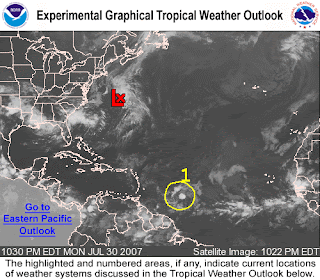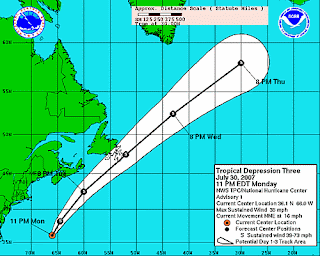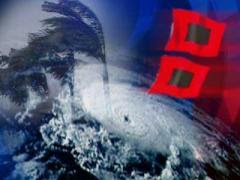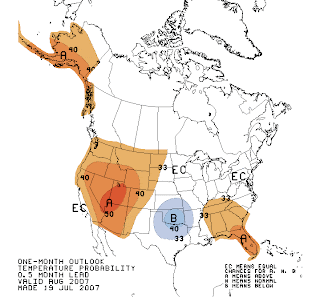As we enter the 2nd half of 2007, it will come as no surprise to most of us that 2007 has been warmer and drier. Late June and July have given us some hope that a "wetter" pattern might stick around for a while. Actually, July has been near normal for rainfall, and below normal for temperatures during the first half of the month. NOAA issued a press release Tuesday that gives us an update of the US and global weather stats for the first half of 2007. Here is the full text of the press release:
2007 WARMER, DRIER THAN AVERAGE FOR MUCH OF U.S.,
GLOBAL AVERAGE TEMPERATURE SECOND WARMEST ON RECORD SINCE JANUARY
Warmer- and drier-than-average conditions
dominated much of the United States during the
first half of 2007, according to scientists at
NOAA's National Climatic Data Center in
Asheville, N.C. The lack of precipitation led to
widespread drought, which triggered an early
start to the wildfire season, mounting crop
losses and local drought emergencies. However,
drought in the southern and central Plains gave
way to heavy and persistent rains which led to
devastating flooding from Texas to Kansas in
June. Meanwhile, the global average temperature
was the second warmest on record for the January-June six-month period.
U.S. Temperature Highlights
- For the contiguous United States, the first
half of 2007 was the 18th warmest January-June
since records began in 1895. The six-month mean
temperature was 1.3° F (0.7° C) above the 20th
century average of 48.4° F (9.1° C).
- Temperatures were much warmer than average from
the mid-Atlantic and Midwest to the northern
Plains and throughout the West. In the contiguous
U.S. only Texas was cooler than average, while
near-average temperatures were widespread across
the South and Northeast. Alaska was 0.3° F (0.2°
C) below the 1971-2000 mean for the January-June period.
- June 2007 was the 23rd warmest June on record,
1.4° F (0.8° C) above the 20th century average of
69.3° F. The warmer-than-average June
temperature helped increase residential energy
needs for the nation. Using the Residential
Energy Demand Temperature Index (REDTI - an index
developed at NOAA to relate energy usage to
climate), the nation's residential energy demand
was approximately 1.5 percent higher than what
would have occurred under average climate conditions for the month.
U.S. Precipitation Highlights
- The year began with widespread severe drought
in the southern and central Plains, Wyoming, the
western High Plains, and northern Minnesota.
Above average precipitation helped ease or end
drought in many of these areas by mid year, but
this was not enough to overcome an extremely dry
winter and spring throughout most of the West.
Meanwhile, much-below-average precipitation
caused drought to develop in the Deep South.
- Four of the first six months of the year were
wetter, or much wetter, than average in Texas,
Oklahoma and Kansas. The wet period was
punctuated by heavy and persistent rains in June
that produced devastating flooding in the region
and the continued threat of flooding into early
July. Monthly rainfall totals exceeded one foot in some locations.
- Much of the West and the South suffered from
extreme drought conditions brought about by
months of below average precipitation.
- An extremely low winter and spring snowpack
throughout the West combined with above average
temperatures in the spring and early summer set
the stage for an early start to the wildfire season.
- It was the second driest January-June and
driest April-June on record in the Southeast. By
the end of June, 65 percent of the region was in
drought. Alabama was hardest hit, with 86 percent
of the state's pasture and range lands in poor --
or very poor -- condition in early July,
according to the U.S. Department of Agriculture.
The entire state was declared a drought disaster area.
Global Highlights
- The combined global land and ocean surface
temperature was the second warmest on record for
the January-June six-month period. Separately,
the global January-June land-surface temperature
was warmest on record, while the ocean-surface
temperature was the sixth warmest in the 128-year period of record.
- For June, the combined global land and ocean
surface temperature was the fourth warmest on
record as neutral El Nino/Southern Oscillation
(ENSO) conditions contributed to an overall lower global ranking for the month.
- Above average temperatures covered much of the
world's land surfaces during the first half of
the year. While some land areas in the Southern
Hemisphere began the June-August winter season
with below average temperatures, it was the
warmest June on record at the South Pole.














